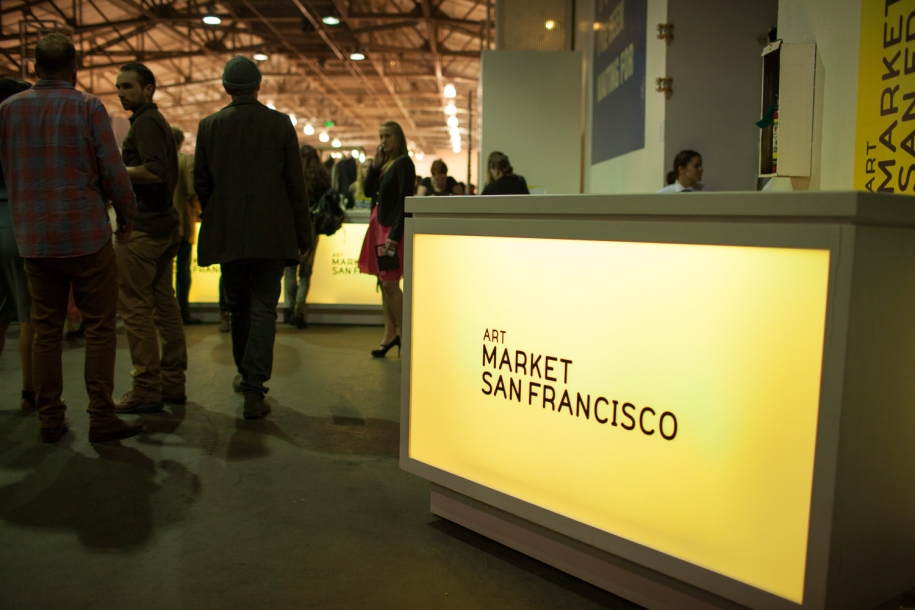Art Market San Francisco
© 2014, Art Market San Francisco
Among the many joys of contemporary art—for viewers and collectors certainly, but also for the artists—is the discovery of unexpected insights into the nature of representation and understanding. And while this may be true of art in general, contemporary art seems to especially revel in the clever, the ingenious, and the unanticipated.
For four days starting on May 15th last month, the Fort Mason Festival Pavilion showcased a rich and varied collection of contemporary art, presented as part of the Art Market San Francisco international fair. The high-energy—and well-attended—show provided the opportunity for art lovers and collectors to engage with some fantastic pieces offered by a diverse group of domestic and international artists (and their dealers).
The brief survey that follows highlights only a few of the many acclaimed works on display at the fair. However, each combines the exhilaration and ingenuity that I particularly crave when searching for new art and artists.
Exploring The Art
Combining a meticulous hand with an interest in dissecting and interpreting lexical constructs, London-based artist Kim Rugg drew attention with two skillfully-drafted ink on paper works: The View from Oregon, 2014 and Big California, 2014. Ignoring boundaries, topologies, or political constructs of any sort, both works simply position community names in their expected locations, highlighting how these distinct entities play a supporting role within the mosaic of the larger.
Rugg is known for similar deconstructions of newspapers, magazines, and other media, notably crafting intricate cut-ups of the New York Times andThe Daily Telegraph, rearranging individual letters alphabetically and by size to create unreadable, yet information-rich, reinterpretations of these everyday resources.
In a similar vein, Los Angeles-based artist Lynn Aldrich strives to make the common uncommon. In Aldrich’s case, however, the focus is on otherwise mundane household objects that include kitchen sponges, garden hoses, drainage pipes, and T-shirts. In the process, Aldrich asks us to reengage with everyday objects, especially now that they have been theatrically transformed from their ordinary function and placement.
This has the whimsical taking on unexpected philosophical dimensions, allowing us to step back and re-examine our modern consumer society a bit more closely that we might otherwise. “Materials are ordinary, but I would like to generate notions of grandeur or the sublime through formal decisions, shifts in scale, and placement within the architecture,” notes Aldrich.
Jason Salavon, in contrast, asks us to focus our attention on the ephemeral world of digital media, exploring the relationship between human communication and machine aesthetics. Or perhaps defocus might be a better characterization. Using computers as full collaborative tools, the Chicago-based artist has devised a set of algorithms and processes to extract correlations and inferences from routine online images, such as a database of realtor photographs, to generate alternate representations.
With the purpose of the original media removed, using overlays or through mathematical averaging, viewers can concentrate on the machine-derived aesthetic patterns inherent in otherwise very human activities. An example of this is One Week Skin (CNN), 2012, which represents a graphic reformulation (or “skin”) of a week of CNN broadcasts. Salavon has completed similar explorations based on Playboy centerfolds (Every Playboy Centerfold, 1988-1997, 1998), weddings and graduations (100 Special Moments, 2004) and late night talk shows (The Late Night Triad, 2003), among others.
San Francisco-based artist Jeffrey Palladini also deftly mixes analog with digital in the Monitor Paintings series, which feature simplistically painted figures in the foreground, motionless, while a digital video image flows constantly in the background (and within the presumed gaze of the foreground figure). The effect is striking. Contrasting the abstraction and passivity of the foreground is the fluidity and consistency of the world always in motion, never at rest.
Adding to the intrigue, the foreground figures are presented with averted faces, placing the viewer squarely in the context of Palladini’s constructions, as if we are merely another inert actor, helpless as a sequence of events unspool before us. While the works do include a video component, Palladini wants us to think of them as paintings—two-dimensional and intended to be displayed on a wall without intervention.
Finally, artist Hwang Seon Tae offers a similarly clever take on the relationship between viewers and their surroundings with a series of minimalist interior paintings featuring light—actual light—emanating through the painted windows onto the enclosed objects and space. Hwang, who was born in South Korea but studied art and design in Germany, creates this impressive and immediately engaging effect using LED backlighting, capturing the calmness and serenity of an unhurried morning, one might imagine, using the warmth of the light itself to emphasize the suspended nature of the captured moment.
In Summary
Of course, these artists represent only a small sample of the breadth of work on display at Art Market San Francisco. But common themes were evident, including the desire to imbue commonplace objects with robust interpretation, forcing viewers to look past the everyday uses and meanings for deeper understanding. And that, after all, is what makes contemporary art so wonderfully exciting.

